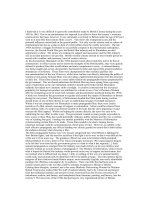THE LIMIT OF A FUNCTION
Bạn đang xem bản rút gọn của tài liệu. Xem và tải ngay bản đầy đủ của tài liệu tại đây (706.37 KB, 60 trang )
SECTION 1.3
THE LIMIT OF A
FUNCTION
THE LIMIT OF A FUNCTION
Our aim in this section is to explore the
meaning of the limit of a function. We begin by
showing how the idea of a limit arises when we
try to find the velocity of a falling ball.
1.3 P2
Example 1
Suppose that a ball is dropped from the upper
observation deck of the CN Tower in Toronto,
450 m above the ground.
Find the velocity of the
ball after 5 seconds.
1.3 P3
Example 1 SOLUTION
Through experiments carried out four centuries
ago, Galileo discovered that the distance fallen
by any freely falling body is proportional to the
square of the time it has been falling.
Remember, this model neglects air resistance.
If the distance fallen after t seconds is denoted
by s(t) and measured in meters, then Galileo’s
law is expressed by the following equation.
s(t) = 4.9t2
1.3 P4
Example 1 SOLUTION
The difficulty in finding the velocity after 5 s is
that you are dealing with a single instant of time
(t = 5).
No time interval is involved.
However, we can approximate the desired
quantity by computing the average velocity over
the brief time interval of a tenth of a second
(from t = 5 to t = 5.1).
1.3 P5
Example 1 SOLUTION
change in position
average velocity =
time elapsed
s ( 5.1) − s ( 5 )
=
0.1
4.9 ( 5.1) − 4.9 ( 5 )
=
0.1
= 49.49 m/s
2
2
1.3 P6
Example 1 SOLUTION
The table shows the results of similar
calculations of the average velocity over
successively smaller time periods.
It appears that, as we shorten the time period, the
average velocity is becoming closer to 49 m/s.
1.3 P7
Example 1 SOLUTION
The instantaneous velocity when t = 5 is
defined to be the limiting value of these average
velocities over shorter and shorter time periods
that start at t = 5.
Thus, the (instantaneous) velocity after 5 s is:
v = 49 m/s
1.3 P8
INTUITIVE DEFINITION OF A LIMIT
Let’s investigate the behavior of the function f
defined by f(x) = x2 – x + 2 for values of x near
2.
The following table gives values of f(x) for values of
x close to 2, but not equal to 2.
1.3 P9
INTUITIVE DEFINITION OF A LIMIT
From the table and the graph of f (a parabola)
shown in Figure 1, we see that, when x is close
to 2 (on either side of 2), f(x) is close to 4.
1.3 P10
INTUITIVE DEFINITION OF A LIMIT
In fact, it appears that we can make the values
of f(x) as close as we like to 4 by taking x
sufficiently close to 2.
We express this by saying “the limit of the
function f(x) = x2 – x + 2 as x approaches 2 is
equal to 4.”
The notation for this is:
lim ( x 2 − x + 2 ) = 4
x→2
1.3 P11
Definition 1
We write
lim f ( x ) = L
x→a
and say
“the limit of f(x), as x approaches a, equals L”
if we can make the values of f(x) arbitrarily
close to L (as close to L as we like) by taking x
to be sufficiently close to a (on either side of a)
but not equal to a.
1.3 P12
THE LIMIT OF A FUNCTION
Roughly speaking, this says that the values of
f(x) tend to get closer and closer to the number L
as x gets closer and closer to the number a (from
either side of a) but x ≠ a.
An alternative notation for
lim f ( x ) = L
x→a
is f ( x) → L as x → a
which is usually read “f(x) approaches L as x
approaches a.”
1.3 P13
THE LIMIT OF A FUNCTION
Notice the phrase “but x ≠ a” in the definition of
limit.
This means that, in finding the limit of f(x) as x
approaches a, we never consider x = a.
In fact, f(x) need not even be defined when x = a.
The only thing that matters is how f is defined near
a.
1.3 P14
THE LIMIT OF A FUNCTION
Figure 2 shows the graphs of three functions.
Note that, in the third graph, f(a) is not defined and,
in the second graph, f (a) ≠ L .
However, in each case, regardless of what happens
f ( x) = L.
at a, it is true that lim
x→a
1.3 P15
Example 2
x −1
Guess the value of lim
.
x →1 x 2 − 1
SOLUTION
Notice that the function f(x) = (x – 1)/(x2 – 1) is not
defined when x = 1.
However, that doesn’t matter—because the
f ( x) says that we consider values of
definition of lim
x→a
x that are close to a but not equal to a.
1.3 P16
Example 2 SOLUTION
The tables give values of
f(x) (correct to six decimal
places) for values of x that
approach 1 (but are not
equal to 1).
On the basis of the values, we
make the guess that
x −1
= 0.5
2
x →1 x − 1
lim
1.3 P17
THE LIMIT OF A FUNCTION
Example 2 is illustrated by the graph of f in
Figure 3.
1.3 P18
THE LIMIT OF A FUNCTION
Now, let’s change f slightly by giving it the
value 2 when x = 1 and calling the resulting
function g:
x −1
if x ≠ 1
2
g ( x ) = x −1
2
if x = 1
This new function g still
has the same limit as x
approaches 1.
See Figure 4.
1.3 P19
Example 3
t2 + 9 − 3
Estimate the value of lim
.
2
t →0
t
SOLUTION
The table lists values of the function for several
values of t near 0.
As t approaches 0,
the values of the function
seem to approach
0.16666666…
So, we guess that:
t2 + 9 − 3 1
lim
=
2
t →0
6
t
1.3 P20
THE LIMIT OF A FUNCTION
What would have happened if we had taken
even smaller values of t?
The table shows the results from one calculator.
You can see that something strange seems to be
happening.
If you try these
calculations on your own
calculator, you might get
different values but,
eventually, you will get
the value 0 if you make
t sufficiently small.
1.3 P21
THE LIMIT OF A FUNCTION
Does this mean that the answer is really 0
instead of 1/6?
No, the value of the limit is 1/6, as we will show in
the next section.
The problem is that the calculator gave false
values because t 2 + 9 is very close to 3 when t is
small.
In fact, when t is sufficiently small, a calculator’s
value for t 2 + 9 is 3.000… to as many digits as the
calculator is capable of carrying.
1.3 P22
THE LIMIT OF A FUNCTION
Something very similar happens when we try to
graph the function
t +9 −3
f ( t) =
t2
of the example on a graphing calculator or
computer.
2
1.3 P23
THE LIMIT OF A FUNCTION
These figures show quite accurate graphs of f
and, when we use the trace mode (if available),
we can estimate easily that the limit is about
1/6.
1.3 P24
THE LIMIT OF A FUNCTION
However, if we zoom in too much, then we get
inaccurate graphs—again because of problems
with subtraction.
1.3 P25









